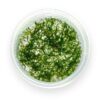Vesicularia ferriei “Weeping Moss”[Tc] is thought to have originated in China and is distributed by Oriental Aquarium Plants. ‘Weeping’ is a fleshy hanging moss that grows to be about 1-3 cm tall and has teardrop-shaped bright green shoots. It works best when attached to driftwood or roots because its drooping growth pattern adds depth and contrast to the aquarium. ‘Weeping’ has low requirements, grows quickly, and should be pruned with scissors on a regular basis to maintain an attractive shape. Ferriaria ferriei ‘Weeping’ is said to have originated in China. It was distributed by Oriental Aquarium Plants. ‘Weeping’ is a densely ramified overhanging moss. While its emerged form has some upright shots, “Weeping moss” develops its characteristic overhanging growth habit under water. This moss is ideal for attaching to decorative driftwood because it adds depth and contrast to any design. Please keep in mind that the shoots of this moss barely attach to the substrate. Weeping moss is easy to maintain and grows quickly. It requires trimming from time to time to keep its unique appearance.
It is said that “Weeping Moss” was imported from China. Prof. B.C. Tan identified it as Vesicularia ferrei (Singapore). This species is also found in southern Japan. It has a creeping habit in nature and grows on wet rocks covered with sandy soil, moist riverbanks, and wet soil on rivulets. (1).
The submerged form of this moss is distinguished by its clearly overhanging frond-shaped shoots (see photos), which resemble weeping willows.
The leaves and relatively broad leaf cells resemble those of V. montagnei (“Christmas moss”), but the leaves are more acute and relatively obtuse rather than acuminate. Other Vesicularia species, including V. montagnei, can have overhanging shoots, but not as bent as V. ferriei, whose shoots are clearly bent downward. However, under very low light conditions, its growth habit may be more horizontal.
Vesicularia ferriei “Weeping Moss”[Tc] was first popular among hobbyists and aquascapers in Asia, but due to its low lighting and fertilisation requirements, as well as its attractive appearance, it quickly spread to European aquaria. Unfortunately, true weeping moss is difficult to find because there are many other mosses sold under that name that do not even have the typical weeping growth habit.
Facts about Weeping Moss
Weeping Moss is a very hardy plant that can grow in a wide range of water and lighting conditions.
Because weeping moss has no roots to anchor into the substrate, it must be attached to something with strings or glue.
Weeping Moss first appeared in the aquarium hobby in 2004. Even today, they are frequently misidentified, so it is important to ensure that the plants are properly labelled.
How Do You Fasten Weeping Moss to Driftwood?
Because weeping moss has no roots, it cannot be anchored into the substrate. Instead, there are a few easy ways to incorporate Weeping Moss into your aquarium. The first method for attaching your Weeping Moss to driftwood or a rock in your aquarium is to wrap some string around the moss and the object to which it will be attached. You won’t have to worry about tying it down with multiple strings or tying multiple knots; a simple once-around the Weeping Moss and the object will suffice. Remember not to tie the knot too tightly, and tie it smugly against the object to which you want it to attach itself.
Super glue is another option for keeping your Weeping Moss in place in your aquarium. The disadvantage is that you will have to remove and blot dry your driftwood or stone in order for it to adhere properly. For this to work, the wood should be slightly damp but not dripping wet. The super glue will discolour the driftwood where it is applied, but the Weeping Moss will quickly cover the area. If you want to place your Weeping Moss in a specific location but don’t want to deal with tying it down or glueing it down, simply weigh it down with rocks. Place the Weeping Moss in the desired location in your aquarium, and then place a few small rocks on top of it to keep it in place. They may knock your fish or snails out of place if you have them in your tank. You’ll want to keep an eye on the moss and may even need to replace the rocks to keep it where you want it.
You can try to incorporate Weeping Moss into driftwood in your aquarium by breaking it up and inserting it into the holes and crevices of your driftwood piece. Weeping Moss will eventually attach and grow in this manner, but keep in mind that if you have fish or other aquatic creatures in your aquarium, they may dislodge the Weeping Moss and you will have to reposition it.
Is it simple to grow Weeping Moss?
It gets its common name from the way it grows in water, which resembles the formation of branches and leaves on a weeping willow tree. Weeping Moss was once considered rare in Europe and America, but with sustainable production levels now available, it has become a popular and easy-to-find plant.
Is Weeping Moss Tough?
It can be grown in a variety of aquarium conditions, making it ideal for breeders, beginners, and everyone else. Aquarium moss is extremely hardy and can survive in a wide range of aquarium conditions.


![Vesicularia ferriei "Weeping Moss"[Tc]](https://elysianflora.com/wp-content/uploads/2021/12/IMG_6746.jpg)





